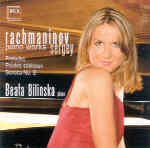Pianist Beata Bilinska has everything it takes for world-class Rachmaninov playing: a big technique, a natural affinity for the composer’s idiom, and a huge, bronze sonority that accommodates the music’s most massive textures without resorting to banging. In passages such as Op. 32 No. 1’s cascading triplets or Op. 23 No. 2’s full-fisted, two-handed chords, where other pianists emphasize power and finger brilliance Bilinska risks slower tempos in order to clarify melodic shapes or harmonic subtleties you’d otherwise not hear. By contrast, the Op. 23 No. 5 G minor prelude’s march-inspired outer sections are appropriately brisk and gruff, while the two Op. 33 selections swirl in multi-colored hues.
Bilinska makes a virtual mini ballet out of the A minor Étude-Tableau, characterizing the scintillating runs and spooky bass-register jabs to convincing extremes. She has a habit, however, of starting certain pieces slowly, then inching up to her intended basic tempo. As a result, the Op. 30 No. 3 Étude-Tableau’s cross-rhythms lose their intended punch (Andrei Gavrilov makes far greater impact by playing them straight), and the Second Sonata’s outer movements sound more rhapsodic than symphonic. Yet Bilinska’s instrumental command and intelligent musicality largely outweigh these reservations. In short, this superbly engineered collection honorably supplements your basic Horowitz, Richter, and Ashkenazy Rachmaninov benchmarks.
































